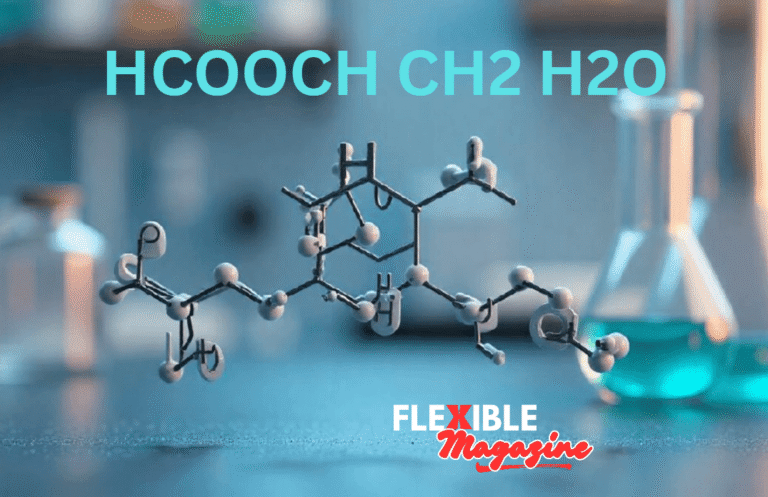Chemistry is a field filled with unique compounds, each contributing significantly to industrial processes, research, and everyday life. Among the lesser-discussed but highly relevant chemical formulas is HCOOCH CH2 H2O. To many, this formula looks unusual at first glance, but upon closer inspection, it represents to an ester-based compound with fascinating properties and wide applications in any chemistry, pharmaceuticals, and organic synthesis.
This comprehensive article explores the structure, formation, properties, reactions, and real-world uses of HCOOCH CH2 H2O, alongside a detailed breakdown of its relevance in modern chemistry. We will also answer common questions to help you fully understand the significance of his compound.
What is HCOOCH CH2 H2O?
The formula HCOOCH CH2 H2O appears to combine formate (HCOO–) with a substituted methylene group and water. In organic chemistry, this type of representation often suggests an ester-hydrate or a chemical intermediate formed during a reaction.
Breaking it down:
- HCOO– → Represents the formate group derived from formic acid (HCOOH).
- CH2 → Indicates a methylene unit, a basic hydrocarbon fragment.
- H2O → Water molecule, often associated with hydration, solvation, or reaction byproducts.
Put together, this formula likely describes methyl formate hydrate or a related ester-hydrate, a structure that appears in esterification reactions and hydrolysis processes. While the notation is not the most conventional, in practical organic chemistry, such expressions often arise when balancing reaction mechanisms.
Historical Background of Formate-Based Compounds
The study of compounds like HCOOCH CH2 H2O dates back to the 19th century when chemists were first exploring esters and their reactions with water. Esters were identified as essential intermediates in alcohol-acid reactions. Formates, in particular, became important because of their role in solvents, adhesives, and as starting points for producing formaldehyde and other industrial chemicals.
Chemists such as Justus von Liebig and Marcellin Berthelot contributed significantly to our understanding of esterification and hydrolysis. The existence of hydrated intermediates (compounds with loosely bound water molecules like H2O) was also confirmed through later research in physical chemistry.
Structure of HCOOCH CH2 H2O
Although the formula appears complex, its structure can be interpreted as follows:
- Formate group (HCOO–): Provides the acidic portion of the compound.
- CH2 group: Acts as a bridge, linking to the ester portion.
- H2O molecule: Suggests hydration or a solvated form of the ester.
This structure is consistent with intermediates found in ester hydrolysis reactions, where water plays a key role in breaking ester bonds.
Properties of HCOOCH CH2 H2O
Like other ester-hydrate structures, HCOOCH CH2 H2O exhibits a range of chemical and physical properties.
1. Physical Properties
- Appearance: Likely a colorless liquid or slightly viscous substance depending on concentration.
- Odor: Esters often have a fruity smell, while hydrated versions can have less distinct odors.
- Solubility: Expected to be soluble in water due to the H2O component.
- Boiling/Melting Points: Vary depending on hydration levels and purity.
2. Chemical Properties
- Reactivity with acids and bases: Easily undergoes hydrolysis in the presence of acids or alkalis.
- Formation of alcohols and acids: Hydrolysis can regenerate formic acid and methanol.
- Hydration stability: The water molecule can be removed or replaced under different conditions.
- Oxidation/Reduction behavior: Formate groups can act as mild reducing agents.
How is HCOOCH CH2 H2O Formed?
This compound is typically formed as an intermediate during reactions involving esters and water.
1. Esterification
When formic acid (HCOOH) reacts with an alcohol in the presence of a catalyst, an ester is formed. Hydration or partial solvation can result in HCOOCH CH2 H2O-like intermediates.
2. Hydrolysis
In the reverse process, esters react with water to yield an acid and alcohol. During hydrolysis, hydrated complexes such as HCOOCH CH2 H2O are often detected.
3. Solvation Effects
Sometimes, water molecules attach loosely to esters through hydrogen bonding, creating hydrated forms.
Industrial Applications of HCOOCH CH2 H2O
Compounds like HCOOCH CH2 H2O are not just theoretical. They are relevant in various industrial sectors:
1. Pharmaceuticals
- Used in the synthesis of drug intermediates.
- Plays a role in ester-based prodrugs, where hydrolysis releases the active component.
2. Polymer Industry
- Ester hydrates are often studied in polymerization reactions.
- Used as solvents and intermediates in making resins and plastics.
3. Perfume and Flavor Industry
- Esters are crucial in producing artificial flavors. Hydrated forms affect stability and solubility.
4. Chemical Research
- Helps in studying reaction kinetics of ester hydrolysis.
- Provides insights into acid-base catalysis mechanisms.
Importance in Organic Chemistry
The presence of HCOOCH CH2 H2O highlights the critical relationship between esters and water. It demonstrates how hydration plays a vital role in stability, solubility, and reactivity.
In reaction mechanisms, intermediates like this explain why certain processes are reversible and how equilibrium is maintained. This is particularly important in fields like biochemistry, where ester hydrolysis is fundamental to metabolism.
Environmental and Safety Considerations
- Biodegradability: Esters and formates are generally biodegradable, making them safer for the environment.
- Toxicity: While small doses are safe, large exposures may cause irritation or toxicity.
- Handling precautions: Should be stored in cool, dry places, away from strong acids and oxidizers.
Future Prospects of Research
As research into green chemistry and sustainable processes grows, compounds like HCOOCH CH2 H2O may play a role in:
- Developing eco-friendly solvents.
- Enhancing the efficiency of catalytic esterification and hydrolysis.
- Serving as intermediates in bio-based chemical production.
FAQs
1. What does HCOOCH CH2 H2O represent?
It represents a hydrated ester-like compound formed from formate, a methylene group, and water. It often appears in ester hydrolysis and solvation studies.
2. Is HCOOCH CH2 H2O stable?
It is stable under mild conditions but can easily break down into formic acid and methanol during hydrolysis.
3. Where is this compound used?
It is mainly used in chemical research, pharmaceutical synthesis, flavor production, and polymer chemistry.
4. How is it related to ester hydrolysis?
It often serves as an intermediate during hydrolysis, highlighting the role of water molecules in breaking ester bonds.
5. Can it be dangerous?
In small amounts, it is relatively safe, but improper handling in industrial concentrations may cause irritation.
6. Is it naturally occurring?
Not directly, but related esters and their hydrated forms occur in biological systems and fermentation processes.
7. Why is hydration important in chemistry?
Hydration changes solubility, reactivity, and stability, making compounds like HCOOCH CH2 H2O significant in reactions.
Conclusion
The chemical formula HCOOCH CH2 H2O may appear puzzling at first, but it represents an important concept in organic chemistry: the role of hydration in ester stability and reactivity. Compounds like this are not only fascinating in theory but also highly relevant in industrial production, pharmaceuticals, flavors, and polymer research.


